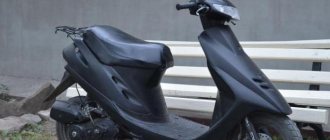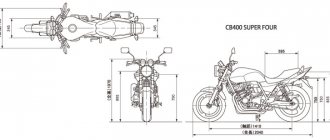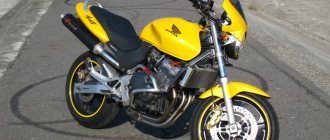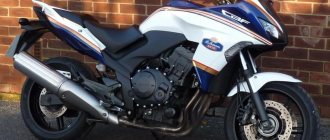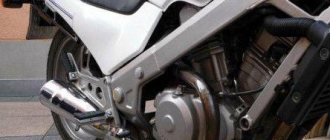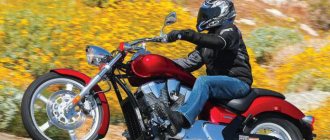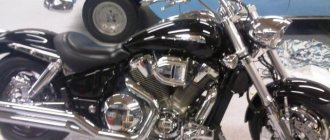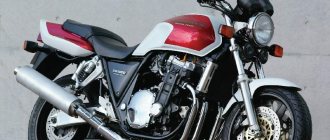The Japanese motorcycle Honda VRX 400 is another attempt by the automotive industry giant to combine a classic model and a cruiser. The modification did not gain much popularity: its release lasted only 4 years (from 1995 to 1999). Against the backdrop of competition, the motorcycle in question from Japan gave way to more powerful analogues and traditional “classics”. In fact, it turned out to be quite a noble motorcycle, incorporating the best of its predecessors.
Exterior
Externally, the Honda VRX 400 Roadster is stylized to resemble the 70s. The unusual V-shaped power unit from Steed adds stylishness and impressiveness to the exterior of the motorcycle. The vehicle in question had four color variations: red, blue, black with chrome inserts, and completely black.
Working metal parts are chrome plated. The exhaust system is bifurcated and expands towards the exit, which adds additional aggressiveness, but in moderation. The bike itself is quite narrow, which gives it the advantage of city riding. The driver's part of the seat is slightly recessed, the steering wheel is of a standard shape with instrument indicators, a control system, a round headlight and turn signals placed on it.
Running performance
In contrast to its retro appearance, the ride quality of the Honda VRX 400 is one hundred percent cruiser-like. The efficient “Stead” power unit produces 33 horsepower with a torque of 34 nm. The five-speed gearbox with long gears allows you to shift quite rarely. At the same time, you can safely start from third position, and engage fifth even at 60 km/h. The possibility of dynamic acceleration is not lost in this case; it is enough to increase the gas supply by turning the corresponding knob.
A considerable part of the structural parts are borrowed from the Steed model:
- Carburetor.
- Chain drive.
- Rear wheels.
- Engine and a few other elements.
But the braking system of the motorcycle in question from Japan is much more effective than that of its brother. This is due to the rear brakes being equipped with a disc mechanism. Also, an original tubular steel frame was created specifically for this “bike”.
Motorcycle Honda VRX 400 Roadster 1995 review
Specifications Honda VRX 400 Roadster 1995
Engine Honda VRX 400 Roadster 1995
Transmission Honda VRX 400 Roadster 1995
Dimensions and weights of Honda VRX 400 Roadster 1995
Chassis and brakes Honda VRX 400 Roadster 1995
Dynamic characteristics of Honda VRX 400 Roadster 1995
Other characteristics of Honda VRX 400 Roadster 1995
Description Honda VRX 400 Roadster 1995
The model of the classic motorcycle Honda VRX 400 Roadster appeared in 1995 and was produced until 1999. The reason for the appearance of this motorcycle was the desire of Honda to release something between a classic motorcycle and a cruiser - between the Honda Bros 400 and the Honda Steed 400. The Honda VRX 400 is based on the same V-shaped 2-cylinder engine with a volume of about 400 cc was taken. see, producing 33 hp. power and 34 Nm of torque.
This engine was installed not only on Steed and Bros, but also on the Honda Transalp 400 almost unchanged.
A total of 4 modifications of the Honda VRX 400 Roadster were produced, differing only in colors:
- black (frame number – NC33-1000001-NH1)
- dark blue (frame number – NC33-1000001-PB-262P)
- dark red (frame number – NC33-1000001-R-204C)
- completely black (Black Edition) – frame number – NC33-1050001-NH1.
The main features of the model include a steel tubular frame, liquid cooling, disc brakes front and rear, simple suspension in the form of a conventional telescopic fork and a classic double shock absorber, and an 11-liter fuel tank.
Like all 400 cc Japanese motorcycles, the Honda VRX 400 Roadster is a domestic model of Japan and was not officially exported to other countries. Average fuel consumption on the Honda VRX 400 Roadster, according to owner reviews, is about 6 liters per 100 km. The price for a Honda VRX 400 Roadster in good technical condition, without mileage in the Russian Federation, is in the range of $2500-3000. The cost of models with mileage in the Russian Federation starts from 120,000 rubles.
- 1995 – start of production and sales of the Honda VRX 400 Roadster.
- 1999 – the model is officially discontinued.
Honda VRX 400 Roadster is an attempt by the Japanese auto-moto giant to release a rather unusual model, crossing a cruiser and a classic motorcycle. Unfortunately, this nice bike was produced for a short time - only four years, from 1995 to 1999, and due to its unusual nature, it did not gain wide popularity. Fans of modern “classics” preferred more powerful models like the Honda CB 400 SF, fans of retro classics preferred the Honda CB 400 SS and Yamaha SR 400... So the VRX 400 turned out to be not very in demand. It's a pity - the motorcycle turned out to be really excellent, without exaggeration.
Taking all the best from two progenitors, Japanese designers created a classic motorcycle that will appeal to those who are nostalgic for Izhu or Java. By crossing the Honda Bros 400 and the Honda Steed 400, they presented the public with a calm, imposing and very, very stylish bike, stylized in the 70s. Of course, the V-twin engine inherited from Steed looks somewhat unusual, but still appropriate. Moreover, this is not the only antique-style motorcycle with a V-twin - there is also the Yamaha SRV 250 Renaissa, for example, and one cannot help but admit that such an engine looks stylish on both of these bikes.
However, although outwardly the Honda VRX 400 exploits the image of a retro motorcycle, and quite successfully, as for driving performance, it is purely cruiser in all respects. The high-torque engine from Steed has excellent traction from the bottom, allowing you to start even in third gear, and produces 33 hp. and 34 nm of torque, and the long gears of the 5-speed gearbox allow you to not shift too often. Fifth can be engaged at least at 60 km/h, without losing the opportunity to accelerate quite dynamically, simply by turning the throttle towards you.
The rest of the design was also largely carried over to the Honda VRX 400 from Steed - a carburetor, a chain drive of the rear wheel... But the steel tubular frame was created specifically for this model, although not innovative. But the VRX400 brakes much more effectively than the Steed - this is due to the fact that the designers equipped the rear wheel of this model with a disc brake rather than a drum brake. In general, braking can be called quite effective, given the imposing nature of the bike.
But you can’t call it light - the dry weight of the Honda VRX 400 is more than 200 kg, which is very, very much by the standards of 400 cc “classics”, but significantly lighter than many cruisers of comparable cubic capacity. There are almost no plastic parts on the motorcycle - everything is made of high-quality steel and covered with high-quality chrome, which on most copies looks great even twenty years after release. And thanks to the moderate seat height and low center of gravity, a couple of hundred pounds of weight is not particularly felt - the VRX400 is easy to control, so the bike is perfect for beginners.
The motorcycle is, of course, unique. The Honda VRX 400 drives like a chopper, but it brakes and handles like a classic, which in this case is a plus. The classic seating position makes it easy to control, and the torquey engine pleasantly pulls the bike out of long turns. To put it simply, it’s simply a pleasure to drive it. On the VRX you don’t want to “unscrew”, you want to leisurely roll at 100-110 km/h and enjoy the pleasant breeze in your face. The only pity is that you can’t go very far on it - the 11-liter tank is enough for a couple of hundred kilometers, and the suspension is a bit harsh. This bike is not for travel, no - it is for the soul. Well, for everyday driving around the city it is no worse suited than for evening trips around the surrounding area, that’s for sure.
Go to the entire range of Honda motorcycles, on this page you can find Honda VRX 400 Roadster motorcycles from other years of production and information about them
Honda VRX 400 Roadster price based on sales advertisements
* Attention! Under the maximum, average and minimum of the Honda VRX 400 Roadster motorcycle on this page, the average cost according to advertisements for sale on the Internet is indicated, without taking into account the year of manufacture, configuration and generation of the motorcycle model.
Sales statistics of Honda VRX 400 Roadster by regions of the Russian Federation (in the form of shares)
- St. Petersburg 15.91%
- Krasnodar region 6.82%
- Moscow region 9.09%
- Tyumen region 4.55%
- Moscow 20.45%
- Omsk region 4.55%
- Rostov region 4.55%
- Saratov region 4.55%
- Crimea 6.82%
- Chelyabinsk region 4.55%
Five random motorcycles:
Five random articles about motorcycles:
IZ Jupiter-3 adjustment to achieve full power
Perform the adjustment “The IZH-Jupiter-3 motorcycle has already covered more than 5,000 km, but, as I can judge from other similar machines, it does not produce full power. What could be the reasons? - asks K. Usoltsev from Magnitogorsk. If the motorcycle was run in correctly, that is, in accordance with the instructions, and the engine has no noticeable defects, it will probably be possible to increase its power by performing the following work. Remove the spark plug and inspect. If there is a lot of carbon on it, it means that the mixture is entering the cylinder too rich, and carbon deposits are also deposited in the combustion chamber and in the exhaust ports. Remove the cylinder and remove carbon deposits from the cylinder head, piston crown and exhaust ports. Using the marks on the cylinder gasket, check whether the contours of the crankcase and cylinder bypass channels completely match and whether the gasket does not overlap them. If necessary, adjust the channels and gasket. Check and, if necessary, set the same ignition timing in both cylinders (2.6.
A journey of half a century. IZH-7, IZH-D, IZH-9, IZH-350, IZH-49, IZH-56, IZH-Planet-4, IZH-Jupiter-4
IZH-7, IZH-D, IZH-9, IZH-350, IZH-49, IZH-56, IZH-Planet, IZH-Jupiter On the outskirts of Izhevsk there is a monument - motorcyclists on rearing cars. It symbolizes the successes of city workers in the production of motorcycles and in the development of motorsports. Half a century ago, in accordance with the decision of the People's Commissariat of Heavy Industry, motorcycle production was organized here in Izhevsk on the basis of the experimental workshops of Izhstalzavod. Even earlier, in 1928, in these workshops, a group of enthusiasts under the leadership of engineer P.V. Mozharov designed and built prototypes of machines. However, due to the lack of production capabilities, it was not possible to launch serial production of motorcycles. Izhevsk residents began producing them in 1933. Between the two models you see in the pictures, there is a journey of half a century. We started with the IZH-7 motorcycle, which differed only in details from the simple L-300 machine with a two-stroke engine, which had been mastered by that time in Leningrad. One of these cars, equipped with the new VMZ.9.702 sidecar, was provided to the editors for testing after a run. It was May when I drove it from Ustinov to Moscow. Of course, I couldn’t wait to experience the motorcycle’s adaptability to changes in road conditions myself, comparing it with Jupiter-4 (“Behind the Wheel,” 1982, No. 7), which had different power characteristics. In Central Asia, I experienced only flat roads, where it was impossible to estimate this indicator. Now the Ustinov-Kazan section was enough to draw the first conclusions. On long horizontal straights I tried to find the minimum speed in direct transmission with which I could accelerate. It turned out that at 30 km/h the engine still runs steadily and jerkily.
Motorcycle IZH Jupiter 4. About operation (after 4 years)
Lessons from Jupiter 4 Interested readers will remember that four years ago the editors of Za Rulem received a Jupiter-4 motorcycle with a sidecar from the Izhevsk plant for consumer testing. We described our impressions received in the process of getting to know this car in sufficient detail in No. 11 for 1981 and No. 7 for 1982. Subsequent trial operation allowed us to accumulate many observations, comments and suggestions on the design of the motorcycle, which we intended to talk about from the pages of the magazine. Fortunately, we did not have the chance to do this. It was fortunate: at the same time, factory specialists intensively improved their car, as a result of which a new model was born - “Jupiter-5” (readers met it in the January issue of “Behind the Wheel” of this year). In the new modification, in one way or another, almost all the issues that arose during the tests of IZ Jupiter-4 were resolved. As far as
Motorcycle IZH Jupiter 4 with sidecar
The first material about editorial tests of the IZH-Jupiter-4 motorcycle with a sidecar (“Behind the Wheel,” 1981, No. 11) talked about what distinguishes this model from the previous ones, and about the beginning of the run-in. Now the motorcycle has covered about 7,000 kilometers, and there is an opportunity to evaluate its driving performance and the design of some components. When the speedometer showed just over 6,000 kilometers and the engine was running perfectly, we began to be bothered by a noise, the source of which was somewhere under the left crankcase cover. The noise is not loud, but quite unpleasant (note that, unfortunately, this sound is well known to many Jupiter fans). The assumption arose that the fault should be looked for in the motor chain drive. When the crankcase cover was removed at a service station in Zagorsk, the diagnosis was confirmed: the motor transmission chain was very stretched. Willy-nilly, I had to replace it with a new one. This fact, naturally, cannot but upset us, since the mileage of the motorcycle is ska.
Design features
The motorcycle in question can hardly be called light. Its weight is over 200 kilograms, which is a bit much by the standards of classic 400cc units. On the other hand, the Honda VRX 400 is lighter than almost all cruisers of a similar size. There is practically no plastic in the equipment. All elements are made of steel and chrome plated, which guarantees their spectacular appearance for decades.
The low center of gravity of the motorcycle and the ideal seat height allow you to forget about the weight of the device. It is easy and comfortable to operate even for a beginner. The reinforced motor easily takes the unit out of turns, and the modified braking system guarantees additional safety. This vehicle is unlikely to be suitable for long trips, since the tank capacity is enough for a couple of hundred kilometers. But for the soul, this is just the thing.
Technical specifications
Honda VRX 400: technical characteristics of the motorcycle are shown in the table.
| Power unit type | V-shaped, four-stroke with a pair of cylinders |
| Torque (max) | 33 Nm (six thousand rpm) |
| Transmission | Mechanics, five-speed |
| Cooling method | Air |
| Fuel tank volume | 11 l |
| Fuel | AI-92 |
| Starting system | Electric starter |
| Engine capacity (cc) | 398 |
| Speed (max)/ km/h | 130 |
| Main gear | Chain |
| Power (hp) | 33 at 7,500 rpm |
| Brake system | Disc with ABS |
| Weight (kg) | 206 |
| Length/height/width (m) | 2,23/1,1/0,76 |
| Seat height (m) | 0,76 |
| Front tire | 120/80 R-17 |
| Rear tire | 140/80 R-17 |
| Motorcycle category | Road |
| Manufacturer | "Honda" |
| Years of manufacture | 1995-1999 |
Motorcycle Honda VRX 400 Roadster
This bike is quite interesting, if only because it is the result of a curious experiment by Honda, which decided to combine the features of a classic and a cruiser in one motorcycle.
Of course, the risk was obvious, because not everyone can understand and accept such a hybrid. It is for this reason that the model did not gain the popularity that, by the way, it deserved.
For whom
Here are the main features of the Honda VRX 400 Roadster:
- stylish exterior;
- A V-twin engine that looks appropriate, but somewhat strange.
calm character;
This bike will be of interest to those who love a variety of motorcycle hybrids. Often such combinations turn out to be unsuccessful, at least in terms of design, but this model boasts a well-thought-out design.
Specifications
The motorcycle's parameters are impressive, if only because it demonstrates significant dynamics on the road, but looks like an alien from the seventies. The ride quality of this bike is cruiser, and there is practically nothing there from the two-wheeled classics.
Engine
The maximum capabilities of the motor are such that it produces a torque of 34 Nm and a power of 33 hp, which is absolutely enough for a bike with this positioning. The engine here has two cylinders, it is four-stroke and V-shaped. Its volume is 398 cm³. The maximum speed is 140 km/h, however, due to its characteristics, the motorcycle is much more suitable for driving at speeds no higher than a hundred. After all, it feels and handles like a cruiser.
Transmission
A five-speed gearbox is absolutely sufficient here, because the bike does not strive to set records. As for the drive, the Honda VRX 400 Roadster has a chain drive, because the dimensions of the car are small, and a cardan is absolutely useless here. The power is completely transferred to the wheel, and the motor realizes its full potential.
Dimensions and weight
Without fuel, this model weighs 190 kg, and with it its weight is 205 kg. The VRX 400 Roadster has a small gas tank with a volume of only 11 liters. For such a motorcycle this is probably enough. In the end, fuel consumption is also low, and on average about 2.7 liters are spent per hundred. The seat height here is 770 mm, and the wheelbase is 1510 mm.
Chassis and brakes
The frame of the bike is tubular and made of steel. It looks great, although it is not clear what class this technological miracle belongs to. The spoked wheels, as well as the steering wheel with characteristic mirrors, give the vehicle a much-needed touch of old-fashionedness.
The VRX 400 Roadster combines a pendulum rear suspension with a pair of shock absorbers with a 41 mm telescopic fork. The rear brake of the motorcycle is a 249 mm disc and a single-piston caliper, and at the front there is a 310 mm disc and a two-piston caliper.
Owner reviews
Owners of a mixture of chopper and road motorcycle emphasize the external extraordinary beauty of the bike, as well as the features of its layout. Among the objective advantages, lovers of two-wheeled cars from Japan note the following aspects:
- A variety of chrome parts and minimal presence of plastic.
- Ease of entry and control of the motorcycle.
- Dynamic and smooth running.
- Decent suspension.
- The power and confidence of a powertrain that performs well at a variety of speeds.
In addition, motorcycle owners note that after purchasing a Honda BPX 400, the desire to change vehicles frequently disappears, since the unit gives a feeling of confidence and reliability. Not without finding disadvantages, of which there are not so many.
Firstly, at speeds over 100 km/h you get the feeling that you are being blown off the motorcycle: stability is lost a little. Secondly, there is no gas gauge and kickstarter. The main problem is that original spare parts for Japanese motorcycles have a high price. Otherwise, users did not find any cons.
MY MOTORCYCLE
The VRX400 was produced exclusively for the Japanese market. This partly explains the fact that it was produced with only a cubic capacity of 400 cubic meters and a relatively small payload mass in the form of a pilot and passenger. Because the difference between the maximum weight of 315 kg and the weight of a motorcycle filled with fluids of 205 kg is only 110 kg. Probably, the designers proceeded from considerations of the average weight of the “rider” of 55 kg.
Partly because of these considerations, the suspension is quite soft. However, some other four-hundreds from Honda also suffer from this sin, in particular the HONDA CB400. This is not surprising, because if you look closely at them, you can find many similarities, for example, the front fork is identical to that of the VRX400.
By the way, the unification of some components of Japanese motorcycles of those years led to the fact that there were no problems with basic consumables. Considering that the reliability of Honda motorcycles is said to be legendary, then basically, with proper maintenance in the form of timely replacement of fluids, filters and seals, there are few problems with them. This fully applies to the Honda VRX400.
The V-Twin engine is one of the most reliable of all produced by the motorcycle industry. It has gone through many editions and is used on almost all possible types of motorcycles - tourers, classics, choppers, enduros. By the way, the closest relative of the Honda VRX400 is the Honda Steed400/600. They were released almost at the same time. There is much more information about Steed. So you can take Steed's repair tips and apply them to the VRX. Even the electrical circuit is 90% compatible.
But let's return to the Honda VRX400. Anyone who is looking at this motorcycle must determine for themselves the purpose of the purchase and realistically assess their desires and its capabilities. This is almost the perfect motorcycle for beginners. He is friendly, does not rush off like a young stallion. The speed picks up smoothly. The seating position is very comfortable. Review too. Medium height saddle. It is also suitable for those who previously had IL or Java. A classic, he is a classic. This is not an enduro - it is too soft for potholes and bumps with the standard suspension. For comparison: the VRX has a little more than 10cm of suspension travel, and the Transalp has more than 17cm.
The maximum speed to which the VRX can be accelerated is 130-140 km/h. The optimal speed is in the range of 80-110 km/h. At the same time, the most economical mode is 80-90 km/h. Whether it’s a little or a lot, everyone decides for himself based on the same proportion of what is desired and what is actual. As for me, these speeds are quite enough for driving with pleasure. During operation, people often came up to me and asked what and how - I honestly answered that the cubic capacity is small, 400 cubic meters, and it also doesn’t go relatively fast - most often on the highway it’s 110-120. I don't speed up anymore. And they reasonably asked me, “Why more?” That's the truth - why?
Public roads are not a testing ground for generating adrenaline. There are activities that are much more suitable for this. Bungee jumping, skydiving, rafting, kayaking, yachting, etc. At the same time, you decide whether to take risks or not, to get adrenaline or not. Without a threat to others, without a threat to their lives. Driving at high speeds requires EXPERIENCE. It is acquired in movement, realizing what you are doing and why you are doing it. Analyzing, learning from your own and others' mistakes.
The meaning of the word “EXPERIENCE” in explanatory dictionaries in relation to driving a motorcycle: - Reflection in human consciousness of the laws of the objective world and social practice, obtained as a result of active practical knowledge. — A set of practically acquired knowledge and skills. - Knowledge of life based on experiences and experiences. — Reproduction of a phenomenon in artificially created conditions for the purpose of its research. — Testing the acquired knowledge empirically. The ideal vehicle for gaining experience is the Honda VRX400 Roadster
As a result, Honda VRX400 Roadster:
Pros: — very good and stable engine operation at low speeds. — comfortable fit — reliable engine — no problems with spare parts — reasonable price — easy to maintain
Cons: - not enough dynamics when transporting 2 people. — a 2-disc front brake would be nice — soft suspension
review from vrx400.ru
Test Drive
The test in question primarily takes into account the dynamic performance of the Honda VRX 400 Roadster motorcycle in relation to its direct competitor, the Suzuki Intruder. There were no questions about the ergonomics of the bike. When picking up speed, you can feel the dynamics, which at 120 km/h noticeably fade away, which is not surprising for this class. The ground clearance is somewhat low, so before bumps you have to significantly reduce your agility.
The vehicle in question reaches its maximum speed rather sadly, although up to a hundred one can feel confidence and acceleration. The rubber of the unit is not designed for speeds above the standard, so the motorcycle begins to wobble. Compared to its predecessor, the Honda VRX 400 has more confident brakes. The vibration load is acceptable and approximately the same among competitors. If we take into account all the indicators, it turns out that the graceful Honda performed better than the bulky Suzuki.
Honda VRX400
Honda VRX400 – photo 1
Honda VRX400 – photo 2
Honda VRX400 – photo 3
Honda VRX400 – photo 4
Honda VRX400 – photo 5
Technical characteristics of Honda VRX400
| Year of issue | 1995 |
| Type | Motorbike |
| Class | Motorcycle road |
| Length, mm | 2235 |
| Width, mm | 760 |
| Height, mm | 1105 |
| Seat height, mm | 760 |
| Country of assembly | Japan |
Modifications of Honda VRX400
Honda VRX400 Roadster
| Maximum speed, km/h | 130 |
| Acceleration time to 100 km/h, sec | – |
| Engine | Gasoline carburetor |
| Number of cylinders / arrangement | 2/V-shaped |
| Number of bars | 4 |
| Working volume, cm 3 | 398 |
| Power, hp / rpm | 33/7500 |
| Torque, N m / rpm | 33/6000 |
| Fuel consumption, l per 100 km | 4.0 |
| Curb weight, kg | 190 |
| Gearbox type | Mechanical |
| Cooling system | Air |
| Show all characteristics | |
Odnoklassniki Honda VRX400 price
Unfortunately, this model has no classmates.
Reviews from Honda VRX400 owners
Honda VRX400, 1997
The bike itself is very beautiful. Lots of chrome parts: mufflers, filter cover, speedometer, tachometer, headlight, steering wheel, mirrors, gas tank cap, logos. The exterior of the Honda VRX400 is very specific, because it combines modernity and classics of the genre. A sort of mixture of road builder and chopper. On the one hand you look like a road worker, on the other the rear is a chopper, a chopper engine, a tank - something in between, wheels with spokes. The motorcycle is not tall, very suitable for a girl, but probably not suitable for a tall guy. At low speeds, the Honda VRX400 engine has enormous thrust, which decreases noticeably with increasing speed, however, it is quite enough to feel confident in traffic. If you need fast acceleration, you need to turn the engine up to 7 thousand revolutions; from low gears it accelerates into 4-5 gears extremely reluctantly, that is, you need to use the full potential of the gearbox and engine. But the Honda VRX400 is more intended for leisurely driving for pleasure. But on occasion he allows him to jump and show some impudent person that he shouldn’t offend a lady. True, at a speed of 100 I’m already starting to really be blown off the motorcycle, which was not the case on the YBR at 110. At high speeds, the sense of stability is also lost, but the suspension is a song. It somewhat resembles a limousine; it handles all bumps and bumps very gently. It feels like you're riding on a blanket. On a bad road, the motorcycle is simply the king of the track, you go around a column of cars as if standing still, and at the same time it feels like a boat, smoothly and quickly. There is no Kickstarter, and there is no real need for this anachronism. The engine is clearly eternal, because it is low-speed, powerful, and no excessive loads can kill it. I read on the Internet that it has a 500-thousand-ton engine, I believe it. Smart, it won’t drive with the steps down, and the starter won’t turn on at speed. But at the same time, the absence of a gas gauge after YBR is like a knife in the heart. Direct landing, very comfortable, we are going on a long-distance trip during the holidays, I think the Honda VRX400 will not let me down. High quality workmanship, looks like new, there is no sign of corrosion. True, you cannot turn off the headlight. I haven’t driven it at night yet and it’s hard to say how it will perform, but it doesn’t look powerful.
Advantages
: straight landing. Comfort. Very soft suspension. High-torque.
Flaws
: no fuel level sensor.
Honda VRX400, 1998
First impressions. Launch. The engine of the Honda VRX400 started, and then I heard a caressing gentle sound. My experience driving motorcycles can be equated to zero. But the noble sound of the Honda VRX400 does not frighten or confuse you, like straight-flow sports. On the contrary, it’s even somehow relaxing. He sat down and quietly drove off. I feel like it's a bit heavy at low speeds. I got used to it quickly. I slowly drove home, took gloves and a helmet, and moved to the city center. Fortunately, there are few cars, everything is in the country. I had some doubts about the small number of horses. The motorcycle gave me all the answers. The Honda VRX400 truly carries the soul. It responds nobly to the throttle. Doesn't try to get out from under you. Forgives your inexperience. When upshifting early, it produces a bassy sound without choking or choking. On the contrary, he is trying to reach a speed that is comfortable for him. I was worried that the small number of Honda VRX400 horses would disgrace me in the general flow of cars, where even VAZs would overtake me. But after the first 5 km, I realized that the VRX would not easily be offended, and was capable of showing character within the city. The Honda VRX400 showed me with its character that “I’m not a sport, I’m just a heavy classic, with a big seat, a torquey engine and a soft suspension. I'm just a comfortable motorcycle for a walk and nothing more. So drive calmly and keep your eyes on the road. I won't be capricious and ask unnecessary questions. I’ll do everything myself.” Arriving at the garage, my adrenaline was not flowing like a fountain. I didn’t want to grab my cigarette with trembling hands to calm my nerves. I felt simply rested and calm. For those who are thinking about buying a Honda VRX400, I can say one thing. If you are a very active person. If you want to fly past the girls with a whistle and a wild roar. If you want to burn rubber in the headlights of cars at night. If you want to tear everything you can from the intersection. If you want the roar of your bike to make alarms scream and make your eardrums bleed. Don't buy this motorcycle. It is only for those who came home from work or school nervous. For those who want to be alone with their thoughts. For those who are not in a hurry.
Advantages
: noble sound. Great dynamics. Soft suspension. Forgives mistakes.
Honda VRX400, 1995
Good afternoon. At the beginning of September this year I brought myself this device. Well what can I say. Honda is Honda. Actually, I was aiming for 600, 750cc, but I had to go to the long distance to get them, which is what I was going to do, but I accidentally saw this animal here in Lipetsk, out of curiosity I went to look and I just liked it. I was captivated by both the appearance and the rumors about the extreme reliability of the Steed engine, and no faults were found during inspection and driving. After the enduro, of course, on our roads the backside dries out on the bumps. What does it sound like? I drove almost 1000 km in the fall. Now to the point. Help with advice. Before winter I changed the antifreeze. I drained about 1.5 liters and washed it twice with distilled water. Filled in a new one. Accordingly, only 1.5 liters fit. Although they write everywhere that the volume of the “cooler” is about 2 liters. How is that? By the way, I have never seen the fan turn on. Either it wasn’t brought up to temperature, or maybe it doesn’t work. The Honda VRX400 is not prone to overheating. I drove around the city for half a day, and then you can safely put your hands on the ribs of the cylinders and your hands endure. One more moment. I opened the air vent. There is an oily film on the walls of the filter housing. Tell me what could be the problem. And last week, this bad thing showed up: when the gas suddenly opens, there is a dip in the region of 3-4 thousand rpm. (sometimes there are interruptions in work), then everything is fine. In the spring I'll inspect the spark plugs and work on the carburetors. But extra information won't hurt. That's all for now. We are waiting for spring.
Advantages
: comfortable fit. Soft suspension. Excellent, very reliable motor. Classic motorcycle design.
Modifications
Oddly enough, over the four years of production, the overall layout of the VRX 400 remained almost the same. Basic equipment for all models:
- Power unit from Honda Steed.
- Chromed metal parts with minimal plastic equipment.
- Engine power is 400 cubic centimeters.
- Low-slung and deepened driver's seat.
- A combination of a chopper and a road bike with an extended rear wheel.
- Disc brake system.
Probably the only difference between the generations of the VRX 400 series is the color design. The motorcycle was painted simply in black, red, blue and black with accentuated chrome parts. The model in question can be briefly described as a reliable road motorcycle with cruiser elements.

